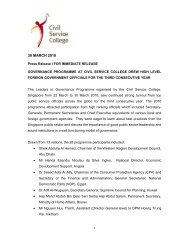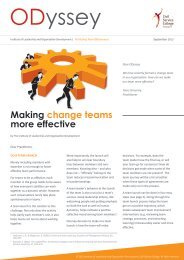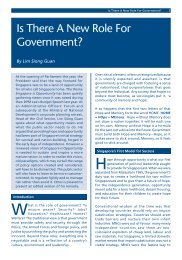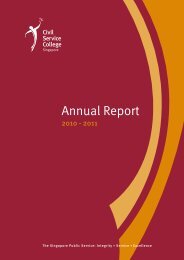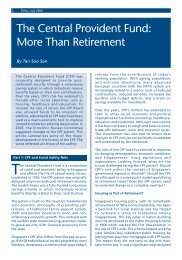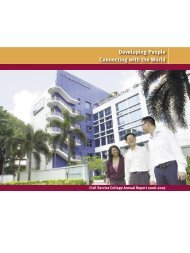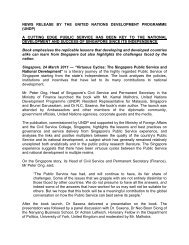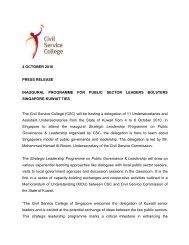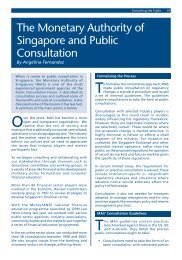Public Consultation Toolkit - Civil Service College
Public Consultation Toolkit - Civil Service College
Public Consultation Toolkit - Civil Service College
You also want an ePaper? Increase the reach of your titles
YUMPU automatically turns print PDFs into web optimized ePapers that Google loves.
<strong>Public</strong> <strong>Consultation</strong> <strong>Toolkit</strong> 39 40 <strong>Public</strong> <strong>Consultation</strong> <strong>Toolkit</strong><br />
In Singapore, the government may wish to also consider a four-phase communication strategy<br />
process 4 to consult on policies/initiatives<br />
6.3. Step 6: Generate awareness and plan<br />
public communication exercises<br />
Generating stakeholder awareness and planning a public communications exercise is a critical<br />
aspect of public consultation. There are generally two approaches for any agency to take as they<br />
prepare for a public communication and awareness exercise:<br />
1. Open consultation – this involves communicating to key stakeholders including the general<br />
public that a consultation exercise is going on. The agency should keep both the broadcast<br />
and print media aware of the issues and the actual consultation process. At the same time,<br />
the agency should try to think ahead and prepare their positions in anticipation of any<br />
difficult issues or responses raised.<br />
2. Closed door consultation – this involves only communicating to a selected or targeted<br />
group and inviting them to participate in the exercise. The consultation is conducted away<br />
from the public eye and the media.<br />
1. Listening phase – an early fact finding stage, where there is no need for any major public<br />
communications campaign. The messages during this phase could be to assure the public<br />
that no decision has been made and that a decision would be made only after rigorous<br />
evaluation of the issues involved.<br />
2. Holding phase – At this stage, press statements can be released to explain rationale for<br />
policy/initiative.<br />
3. <strong>Consultation</strong> phase – At this stage, state explicitly when and how public consultation would<br />
be conducted to ensure the public does not feel that the government has already made up<br />
its mind.<br />
4. Buy-in phase – With the assumption that a decision had been made on the policy/initiative,<br />
the government should explain why it decided on that policy and its plans.<br />
A public communications plan should be developed to provide a structured and well-planned<br />
approach to engage the stakeholders. A suggested communications plan checklist, outlining the<br />
key components of a communications plan, is outlined in Table 6-2.<br />
There are two key objectives in generating awareness:<br />
1. Educating stakeholders on the policy or initiative.<br />
This will increase the likelihood that the feedback<br />
provided will be meaningful.<br />
2. Increasing awareness about the consultation<br />
exercise, to ensure adequate participation from<br />
targeted stakeholders.<br />
Possible channels/platforms for<br />
raising awareness<br />
• Exhibitions and road shows<br />
• Government websites<br />
• Mailers<br />
• New media, e.g., blogs<br />
• Partnerships (with nongovernment<br />
organisations,<br />
business and trade associations,<br />
grassroot leaders<br />
• Media events<br />
• Press releases<br />
• <strong>Public</strong> notices<br />
• Information kits<br />
• Site visits<br />
4 Source: <strong>Public</strong> <strong>Consultation</strong>: Re-inventing Dialogue, Singapore: Centre of Governance and Leadership, <strong>Civil</strong> <strong>Service</strong><br />
<strong>College</strong>, 2004.



